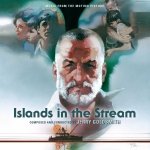

Try
& Buy From

Music Conducted By
Jerry Goldsmith
Orchestrations By
Arthur Morton
Recorded By
-
Performed By
-
Album Produced By
Doug Fake
Label
Film Score Monthly FSMCD
1220
Previous Release(s)
Film Score Monthly FSMCD
1220
US 33 Monogram JG 7711
(Boot)
US 33 Centurion 1210 (Boot)
Year Of CD/Film Release
2024/1977
Running Time
53:17
Availability
Normal Release
Reviewed By
Brandon Moore
Cues
&
Timings
1. Main Title 3:19
2. The Boys Arrive 3:02
3. Pillow Fight 1:12
4. Is Ten Too Old? 4:09
5. Night Attack 3:22
6. The Marlin 11:54
7. The Boys Leave 2:53
8. The Letter 3:28
9. How Long Can You Stay 3:10
10. I Can’t Have Him 2:44
11. The Refugees 4:27
12. Eddie’s Death 4:39
13. It Is All True 5:18
Soundtrack
Ratings
Disappointing

Functional

Average

Good

Excellent

Outstanding

|
Islands In The Stream
Islands in the Stream (1977) was Jerry Goldsmith's fifth
feature score for director Franklin J. Schaffner. The
film is based on one of the last works of Ernest Hemingway, Schaffner's
favourite writer. Goldsmith often described pictures that dealt
with human emotions and relationships as an inspiration to score
and had mentioned on few occasions that Islands in the Stream
was his personal favourite.
This inspiring work uses one of Goldsmith's finest themes written
for the character of Thomas Hudson, (George C. Scott) an artist
who is coming to terms with the separation from his wife and
the relationship with his sons. The theme on solo French horn
is often supplemented by a playful theme for his sons in a slight
diminutive form. Both are tightly connected to one another with
similarities in intervals. Mostly the boy's theme is short with
harp, oboe and pizzicato strings used with accented xylophone
(Pillow Fight, The Letter, Marlin). Most
prominent is the introduction of a central whole tone rising
and falling motif for the sea. It is often played in the clarinet
and becomes an omniscient presence throughout.
The focus of the score delves into the emotions that Hudson keeps
hidden, and Goldsmith establishes more than what is visible on
the surface. The Pillow Fight begins playfully on the
boys theme but soon becomes furious and anguished as Hudson's
younger son Davy continues to focus his fight, hitting on his
father relentlessly after the others have stopped. The music
brings out the hurt and the resentment Davy has for his father
who had once beaten his mother. Marlin, a watershed cue
in the score, is an incredible achievement in Goldsmith's entire
oeuvre. Xylophone begins with the boys theme and horns add plenty
of power on the sea motif under a dramatically stated Hudson's
theme in the strings. Goldsmith weaves the three thematic ideas
together seamlessly as they develop. Trumpets and horns pass
off to each other in a masterful section where the two themes
battle against the sea motif. In subtext, the composer captures
the struggling sides between Davy, who is trying to reel in a
Marlin he has hooked, and his father fighting for his son's love.
Goldsmith's music swells on the cuts to the Marlin leaping out
of the water making the opening motif fully orchestrated. Polyrhythmic
textures (with plenty of 7/8 and 10/8 mixed meters) add to the
flavour of the setting and the excitement. Ultimately the line
breaks, and the fish escapes leaving the father/son struggle
resolved with Hudson's heartbreaking, simple theme on flute solo,
harp and strings.
The Letter opens with a bright use of the boy's theme
in piano and oboe as they are excited to get a letter from their
father. Hudson's theme develops on Flute and then into an atmospheric
sound of clarinet arpeggios and strings over a montage of Hudson
continuing his artwork. Finally, It Is All True closes
the score, with a feeling of surrender as Hudson's theme, scaled
down to a sad piano solo, underscores a dying Hudson while his
confidant, Joseph, pleas for him not to die. The music settles
into the final statement of the theme for the end title.
There is an impressionistic influence on Goldsmith's scores,
more so in music he wrote for Franklin J. Schaffner and works
in the late 70's and early 80's. Impressionism in Islands in
the Stream is uniquely translated into the composer's style giving
the film the perfect sound to emotionally express and support
the picture's story. The film was unfortunately at odds in a
year with releases like Star Wars and Close Encounters
but it's still a thoughtful film and possibly the most touching
of the Goldsmith/Schaffner collaboration.
|
|
|